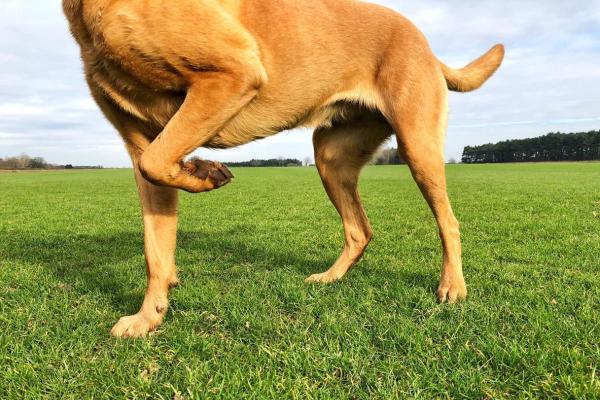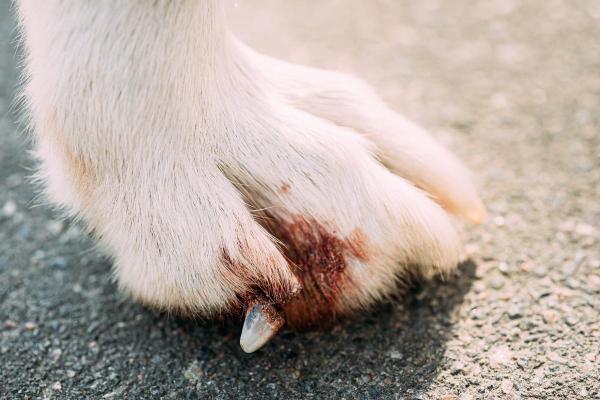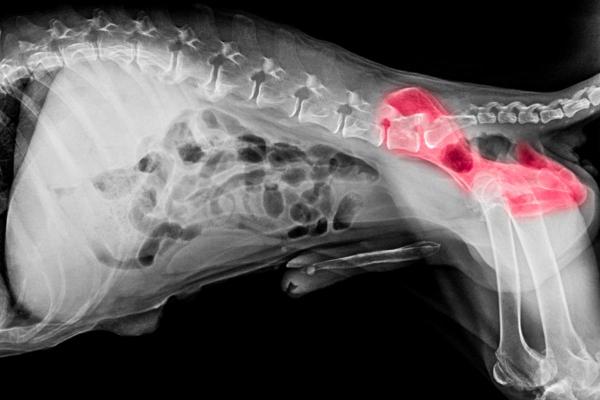My Dog Limps When Walking But Not Running



See files for Dogs
How a dog's limp manifests will depend on its underlying cause. While we may rightly associate limping with trauma, there are other causes of this issue in dogs. Sometimes it can cause the forelimb to be affected, but others affect the hind legs. Some will cause the dog to wobble when they walk, others might cause them to hold their leg up when walking. By looking at the nature of the limp and the context of the dog's symptoms, we can better find out the root cause. One particular symptomology might see that my dog limps when walking, but not running.
In this AnimalWised article, we look at the reasons why a dog is limping at different times, depending on their behavior. We look at the causes and treatment of this limping so you can know what to expect if your dog is affected in this way.
Trauma
Dogs have different energy levels and physical adaptations. Some are very boisterous and can be rough when playing. Despite having energy, others might be a little clumsy when they move. This can be due to age, breed, health and many other factors.
If your dog is adventurous or plays with a lot of enthusiasm, they may be more likely to sustain a traumatic injury. This could be from a fight with another dog, a traffic collision or even a fall from height. However, they do not necessarily need these qualities to hurt themselves. Even the most careful canine can receive a traumatic injury in the right circumstances.
The nature of the dog's limp is dependent on the cause and severity of the injury. If they are involved in a very bad accident, it is possible the dog won't be able to walk at all. In other cases, they might injure themselves in such a way that they limp a little when walking, but are fine when at pace.
Trauma treatment in dogs
Occasional lameness only usually occurs when the trauma is mild. However, we will still need to see the veterinarian. In some cases, the injury may subside on its own with the tissue repairing itself naturally. In other cases, the problem may worsen as the dog continues running on the affected limb. A vet will use palpation, x-rays and other diagnostic tests to determine the nature of the traumatic injury.
In cases of a break, the dog may need a cast. For severe trauma, the dog may need surgical intervention. The treatment will depend on the cause and depend on the veterinarian's discretion.
Muscle injury or tendonitis
Although they can also be caused by trauma, muscle injuries or tendon problems can be a result of many factors. Age is an important one since the natural wear and tear of a dog's life can cause muscles, joints and tendons to become damaged. Diet, exercise levels and other factors can also result in these problems. Especially with tendon inflammation, the problem may not be noticeable when the dog is exercising, but a limp is visible when they slow down.
Treatment for muscle and tendon injuries
Since it can be particularly painful, tendonitis requires treatment with anti-inflammatory analgesics prescribed by the veterinarian. Rest is also needed in the short term, but the dog's diet and exercise levels will need to be adapted to both allow healing of the injury and prevent further damage. Rehabilitation and therapeutic exercises are also very helpful in speeding recovery.
Discover more about a dog's muscles with our article on why a dog has leg cramps.

Wounds, burns and foreign bodies
A dog limping when walking, but not running, is indicative of intermittent lameness. It usually means the issue is not likely to be permanent, although it can be the early symptom of a severe issue. This means that relatively minor injuries such as cuts, scrapes or other wounds caused by trauma, burns or even foreign bodies can cause temporary lameness. in these cases, the dog may limp when walking, but show no signs when running.
One example of a minor injury could be a burn on the dog's paw pads. Before the wound has healed, the dog may experience pain when walking tentatively. When the dog is running, their adrenaline levels might mean their leg is not affected in the same way. Similar injuries include foreign bodies such as a splinter in the paw. This can be very temporary, but if the problem is ignored, a secondary bacterial infection can occur and be very painful.
Treatment of minor wounds
Regardless of whether you detect lameness, it is important that you carefully check a dog's paws when they return from a walk. They could have various foreign bodies in the skin, but may could also have been bitten by a tick or another external parasite. This is especially the case if the dog has been running in long grass.
We can remove the tick from the dog, but we will need to be very careful to ensure we do so safely. If we don't, it can increase the likelihood of the dog developing Lyme disease or other conditions. Splinters are fairly easy to remove, but we need to ensure we sanitize the wound properly or we risk secondary bacterial infection. If we are at all unsure, we will need to speak to a veterinarian.

Osteoarthritis
The pain caused by osteoarthritis is another of the most common causes of lameness in dogs. As it is a degenerative disease, affected animals are usually those of advanced age. Along with limping in the affected limb, the dog may present other typical symptoms. These include the dog having difficult standing up, reduced agility and even excessive licking of certain areas.
Dogs that suffer from osteoarthritis usually limp when they walk after lying down or resting for some time. Their limp becomes less evident as they begin to exercise more. They can even run in an apparently normal way as long as the condition is not very advanced. This is because the joint ‘warms up’ and the animal is able to move more naturally as a result.
Treatment of osteoarthritis in dogs
As osteoarthritis is a chronic and degenerative problem, it cannot be cured. However, early intervention can allow us to reduce the severity of symptoms and prevent further damage. Analgesics may be required in advanced cases to help the dog managed pain. However, it is most important we manage their lifestyle to reduce pressure on the joints. This includes controlling their diet to avoid obesity and ensuring they receive the correct level of exercise.

Dysplasia
Hip dysplasia and elbow dysplasia are degenerative and hereditary osteoarticular pathologies that usually affect large and giant dogs. When the dysplasia is advanced, it causes notable mobility problems and persistent lameness. In the initial stages, it can cause milder and intermittent lameness which presents in limping. It is possible for a dog with dysplasia to run and play without us being able to clearly perceive a limp, but it becomes clearer when the animal walks or performs another specific movement.
In the case of hip dysplasia, dogs tend to keep their hind legs together when they jump. This is especially the case in younger animals. They can appear to make bunny hops and may even have difficult laying down. Elbow dysplasia will have similar symptoms.
Treatment of dysplasia in dogs
Dysplasia can be controlled through drug treatments, but it can also be corrected surgically in some cases. There are also exercises for dogs with hip dysplasia that can help build strength without causing further damage to the joints. You will need to speak to a veterinarian to assess the individual dog and they can advise on the most appropriate treatment.

This article is purely informative. AnimalWised does not have the authority to prescribe any veterinary treatment or create a diagnosis. We invite you to take your pet to the veterinarian if they are suffering from any condition or pain.
If you want to read similar articles to My Dog Limps When Walking But Not Running, we recommend you visit our Other health problems category.








